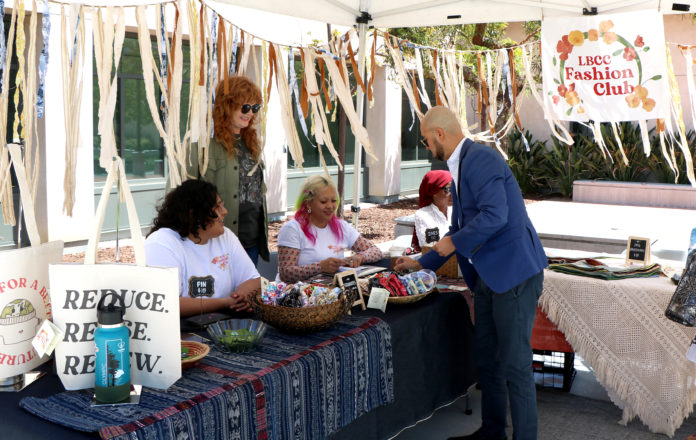[ad_1]

The Long Beach front City University Style Club bought their student-developed upcycled wares outdoors the Viking Bakery Tuesday and Wednesday early morning, when promoting values of sustainability in vogue style and design, drawing passersby, and even LBCC President Mike Munoz dropped in to help fund the club.
The pop-up was open up Tuesday, Could 10, and Wednesday, Could 11, outside the house the Viking Bakery from 10:30 a.m. to 1 p.m.

Put alongside one another by the Manner Club and showcasing the designs and sewing perform by pupils in the Style Advertising class, the pop-up shop’s wares had been motivated by the picked topic of reuse and upcycling, the apply of repurposing applied products to develop something else of higher quality.
“We collectively chose the concept to guidance sustainability practices and we ran with ‘Boro’ the moment we investigated the course of action and supplies,” mentioned Mindy Ngo, Manner Club member.
Boro is a centuries-old Japanese textile practice of using outdated, made use of materials to develop new, patchwork models and solutions.

On the other hand, there are positives and negatives to a manner designer reusing existing components.
“I find it liberating, in particular individually finishing items that are special in their own way,” Ngo explained. “But it can be somewhat constraining much too, considering the fact that (the materials) may well not be my perfect decision. It’s good to have wide range and choices.”
“And ‘Boro’ is really specialized niche, but it is been carried out for hundreds and hundreds of years,” claimed Maria Moreira, one more Trend Club member.

With Ernie the Earth, a college student-intended informal mascot for the pop-up featured in the course of the shop, difficulties of environmental duty can be deeply tied to how trend structure is developed.
“Students are showing interest in sustainable manner,” Bryant mentioned, “Hemp cloth is coming back. We go over synthetic materials, which are generated applying fossil fuels, vs . organic and natural materials.”
“We do what we can, but there are sometimes challenges with organic and natural elements, like recycled cotton,” stated Armando Avelar, a Fashion Club member, recounting challenges using conventional monitor printing on recycled cotton tote baggage.

But distinctive technologies and techniques are generating a lot more sustainable ways to style much easier.
“We obtained a Potent Workforce grant for a direct to garment printer, which is substantially much more sustainable and allows us print these totes with student designs,” Bryant mentioned.
Even style is not exempt from obtaining to rethink its methods as weather improve developments and planetary wellbeing falters.
“Textile and h2o waste is a significant concern. The notion of repurposing components assists a good deal (to fix that),” Moreira claimed.
For a lifestyle used to uncomplicated and cheap clothes solutions, some are starting to question the way fashion is created.
“We are observing that strategy surfacing off social media a ton now. Investigate brands to see what they generate, how they make it, and how they deal with their personnel,” Moreira mentioned.
“It’s about quick vogue versus gradual manner,” Bryant agreed.
[ad_2]
Supply url


